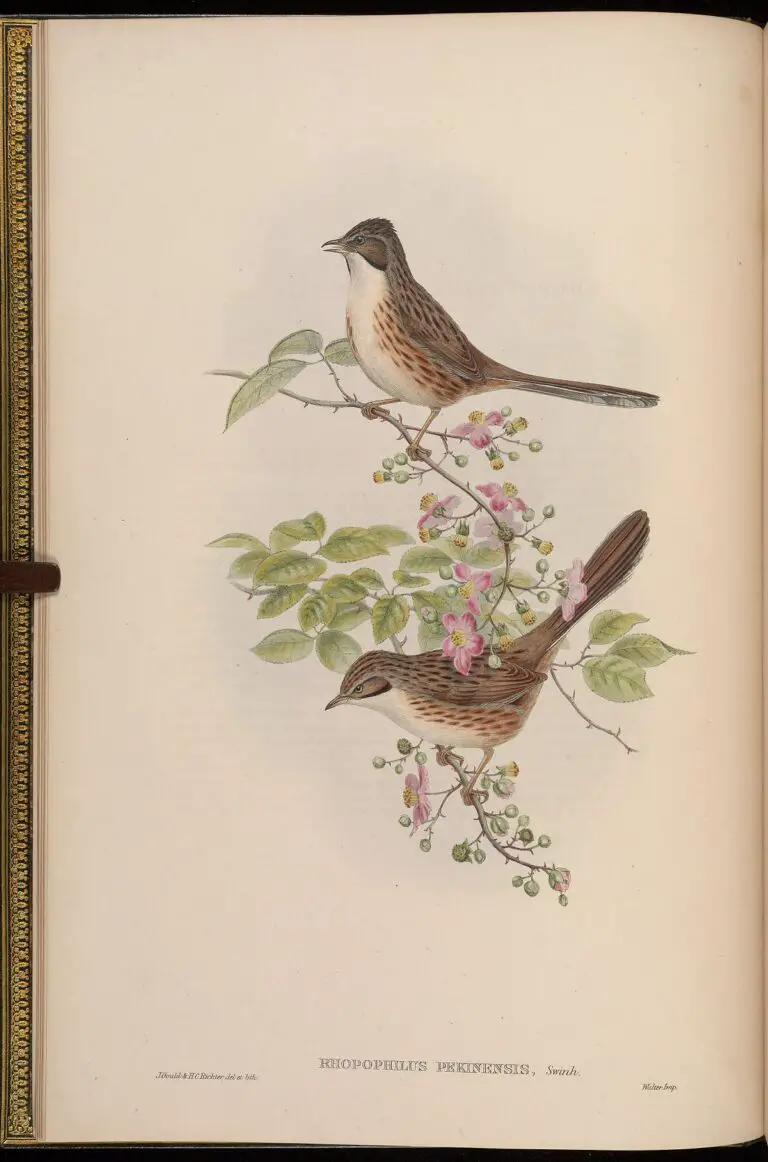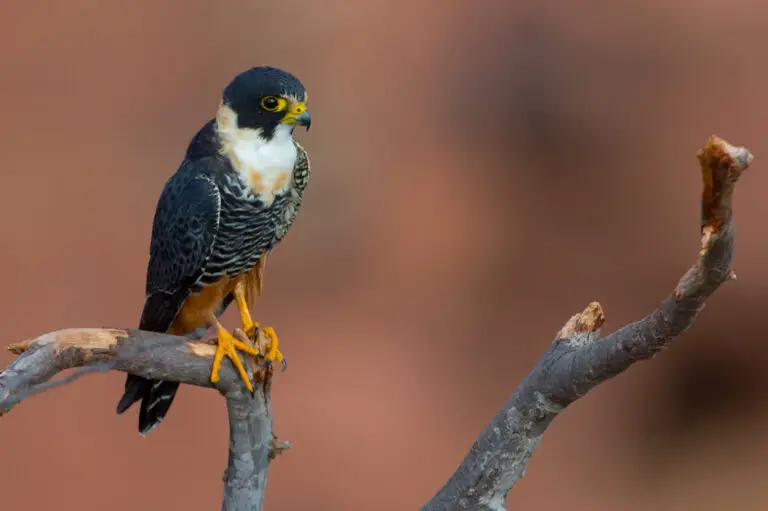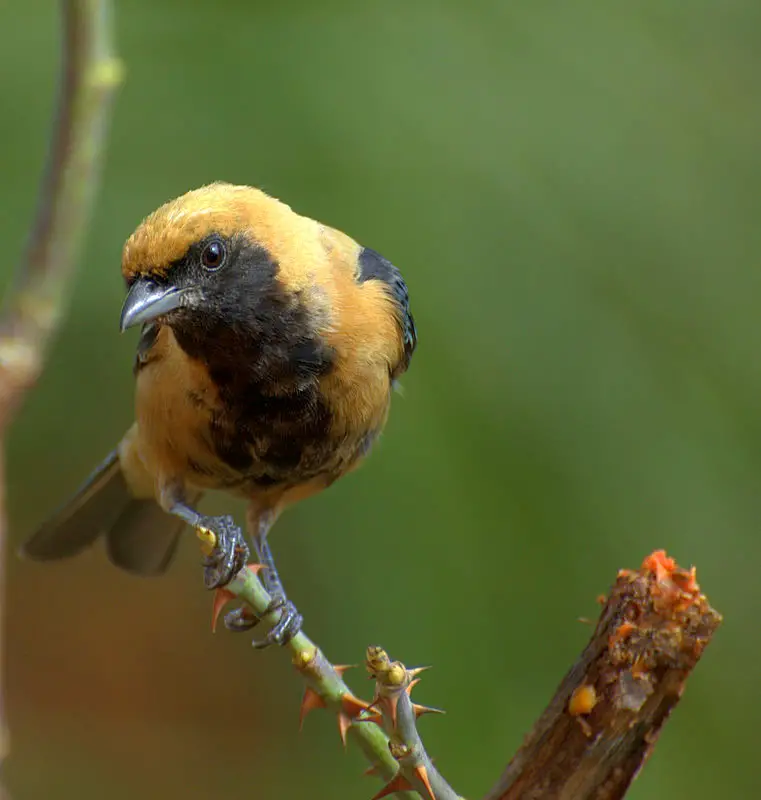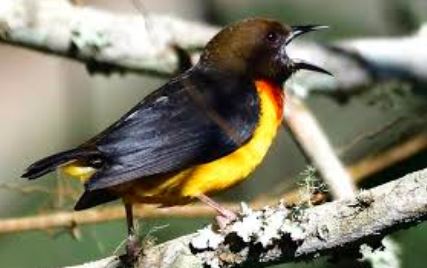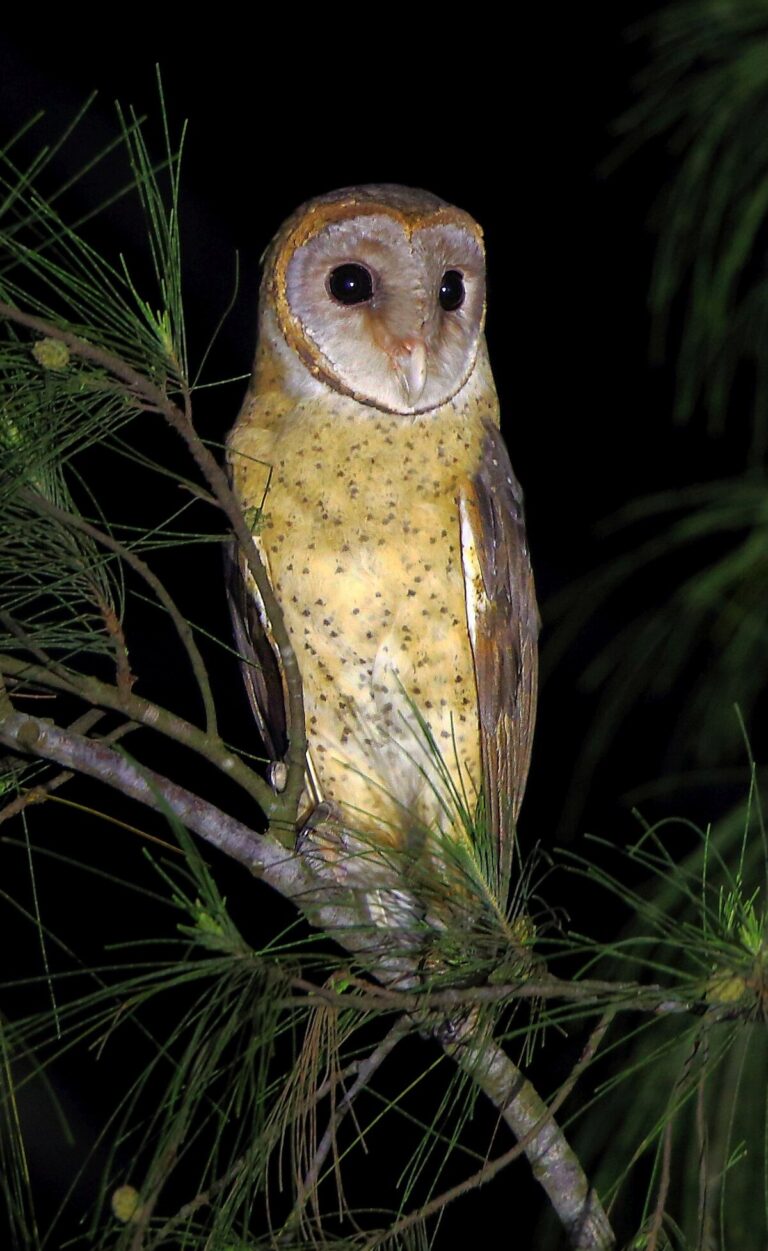Mourning Dove (Zenaida macroura)
“It is almost always the male who makes the famous sad sound, which is a wooing call”
The scientific classification of the Mourning Dove is mentioned below:
- Kingdom: Animalia
- Phylum: Chordata
- Class: Aves
- Order: Columbiformes
- Family: Columbidae
- Genus: Zenaida
- Scientific Name: Zenaida macroura
This gentle bird falls under the least concern category in terms of conservation status, signifying a healthy population. You can find the Mourning Dove in various locations across Central America and North America. If you’re interested in learning more about animal classification, feel free to explore our Complete Guide to the Classification of Animals.
Here are some facts about the Mourning Dove:
- Fun Fact: The iconic mournful cooing sound associated with this bird is typically produced by the male, serving as a wooing call.
- Estimated Population Size: There are an estimated 475 million Mourning Doves worldwide.
- Biggest Threat: Cats pose a significant threat to Mourning Doves.
- Most Distinctive Feature: Their silhouette, whether perched or in flight, is a distinctive characteristic used for identification.
- Other Name(s): The Mourning Dove is also known as the Rain Dove or Turtle Dove.
- Wingspan: Ranges from 37 to 45 cm (14.6 to 17.7 inches).
- Incubation Period: Eggs are typically incubated for about 14 days or 2 weeks.
- Predators: Diurnal birds of prey and cats are among the main predators of Mourning Doves.
- Diet: Mourning Doves are herbivores with seeds being their favorite food.
- Type: Classified as Neoavian.
- Common Name: Also referred to as the American Mourning Dove.
- Number Of Species: There are five species within the Mourning Dove family.
- Location: Found in the southwestern US, Mexico, southern Canada, and Panama.
- Nesting Location: Mourning Doves nest in trees, shrubs, vines, buildings, hanging flower pots, and on the ground.
- Age of Molting: Molting typically occurs at around 3 months of age.
- Migratory: Mourning Doves are migratory birds.
Physical Characteristics:
- Color: Grey-Brown
- Top Speed: Can reach speeds of up to 55 mph.
- Lifespan: In the wild, they typically live between 1.5 to 5 years, but can live up to 19 years in captivity.
- Weight: Mourning Doves weigh between 96 to 170 grams (3.4 to 6.0 ounces).
- Length: Their length ranges from 22.5 to 36 cm (8.9 to 14.2 inches).
The Mourning Dove, also known as the American Mourning Dove, Grey Dove, Rain Dove, or Turtle Dove, has a rich history and symbolic significance. Once referred to as the Carolina Pigeon or Carolina Turtledove, this bird holds a special place in both natural history and human culture.
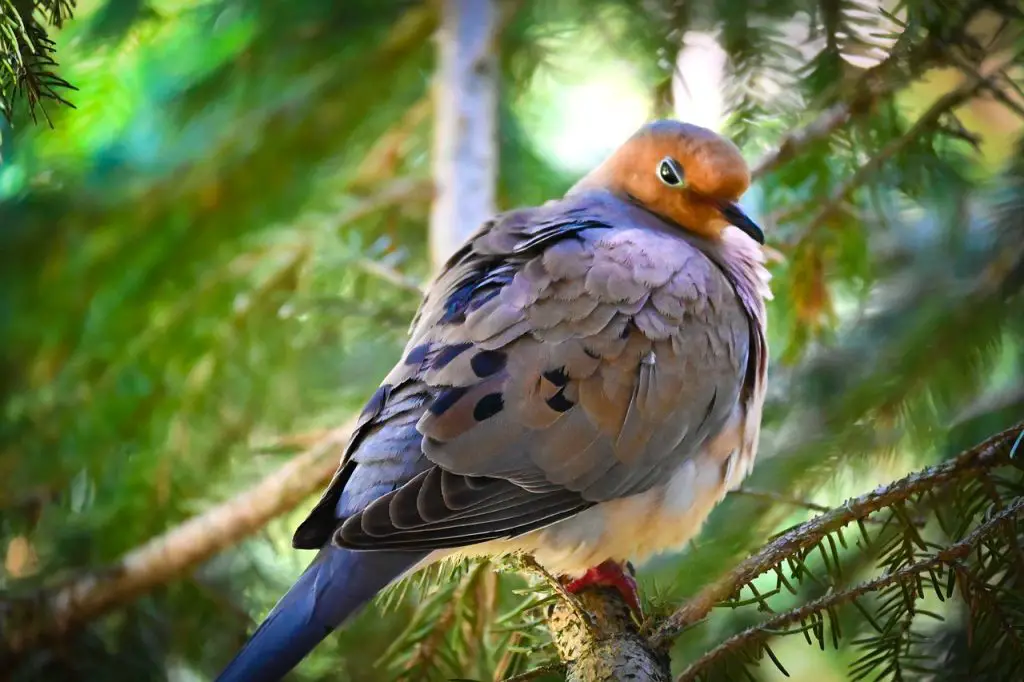
Belonging to the dove family, Columbidae, the Mourning Dove is one of the most familiar birds in North America. Its distinctive silhouette, mournful call, and profound symbolism make it instantly recognizable and deeply ingrained in our collective consciousness.
Symbolizing concepts such as peace, grief, love, friendship, and companionship, the Mourning Dove holds a special place in folklore, literature, and art.
Despite facing threats from predators like cats, the Mourning Dove population is actually on the rise. This resilience is a testament to its adaptability and the efforts dedicated to its conservation.
As a species that resonates deeply with people across cultures and generations, the Mourning Dove continues to captivate and inspire admiration, serving as a reminder of the enduring bond between humans and the natural world.
Amazing Facts
The Mourning Dove is known by a variety of names including the American Mourning Dove, Carolina Dove, Carolina Pigeon, Carolina Turtle Dove, Rain Dove, Turtle Dove, and Western Turtle Dove.
Its common name, “American Mourning Dove,” helps differentiate it from its distant relative, the mourning collared dove (Streptopelia decipiens) of Africa.
One of its most distinctive features is its silhouette, easily recognizable whether it’s perched or in flight.
The mournful cooOOoo-woo-woo-woooo sound of its call is often mistaken for the hooting of an owl, adding to its mystique.
Unfortunately, the Mourning Dove faces a risk of lead poisoning from ingesting leftover shot in hunting fields, highlighting the importance of responsible hunting practices for the protection of wildlife.
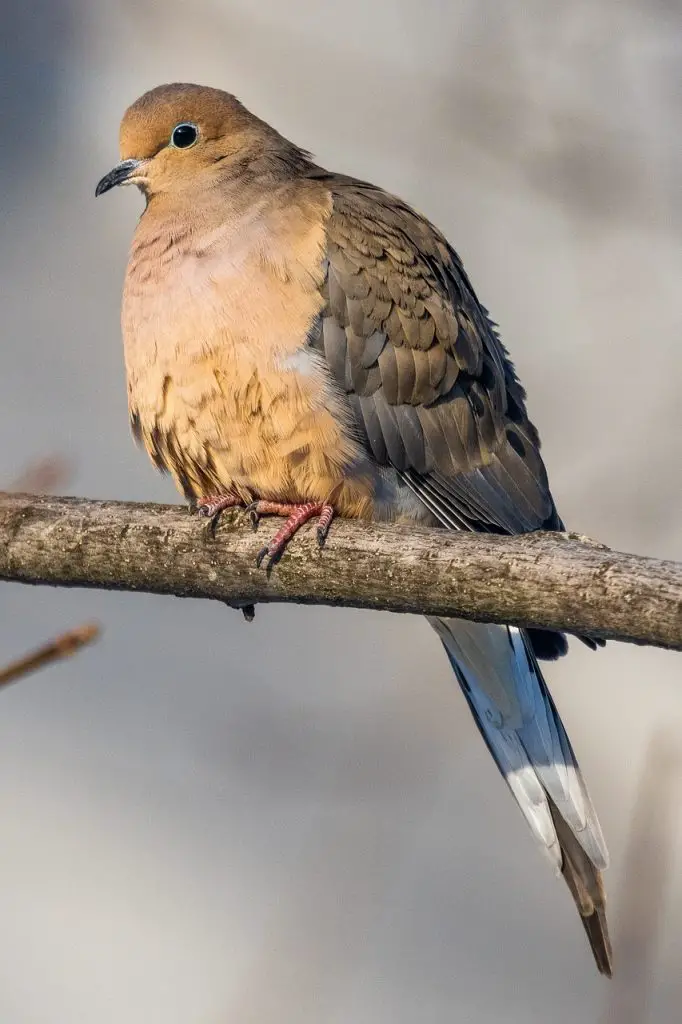
Where To Find Mourning Doves
Mourning Doves, native to North America, boast an extensive range spanning nearly 11,000,000 square kilometers (4,200,000 square miles). Their habitat encompasses southern Canada, the southwestern United States, the Greater Antilles, Bermuda in the Atlantic archipelago, as well as regions in south-central Mexico and Panama.
While these elegant birds primarily inhabit open and semi-open environments, such as prairies, grasslands, farms, and light woods, they have also adapted to human-modified landscapes. It’s not uncommon to spot them in urban and suburban neighborhoods, where they add their soothing presence to the surroundings. You might catch sight of them in expansive open areas, along roadsides, or gracefully perched atop telephone poles, making their mark in both natural and human-influenced landscapes.
Interestingly, Mourning Doves were introduced to Hawaii in 1963, further expanding their geographical footprint and introducing their gentle demeanor to yet another corner of the world.
Nests
Mourning Doves showcase remarkable adaptability when it comes to selecting their nesting sites. While their preferred choice leans towards dense deciduous and coniferous trees, they’re not picky and can craft their nests in a variety of locations. From shrubs and vines to buildings and even hanging flower pots, Mourning Doves exhibit a versatile nesting behavior.
Interestingly, when options are limited, they don’t hesitate to resort to the ground as a last refuge for nest building. This flexibility allows them to thrive in diverse environments, from natural woodlands to urban landscapes.
Nest building typically commences in March, reaching its peak during the breeding season from April to July. During this time, female doves take the lead in constructing the nest, with males providing assistance. Their nests, loosely constructed from twigs, conifer needles, and grass blades, reflect their resourcefulness and adaptability.
Moreover, Mourning Doves display a clever strategy of utilizing unused nests from other Mourning Doves, as well as those from different bird species or even tree-dwelling animals like squirrels. This adaptive behavior not only conserves energy but also ensures the availability of suitable nesting sites during the breeding season.
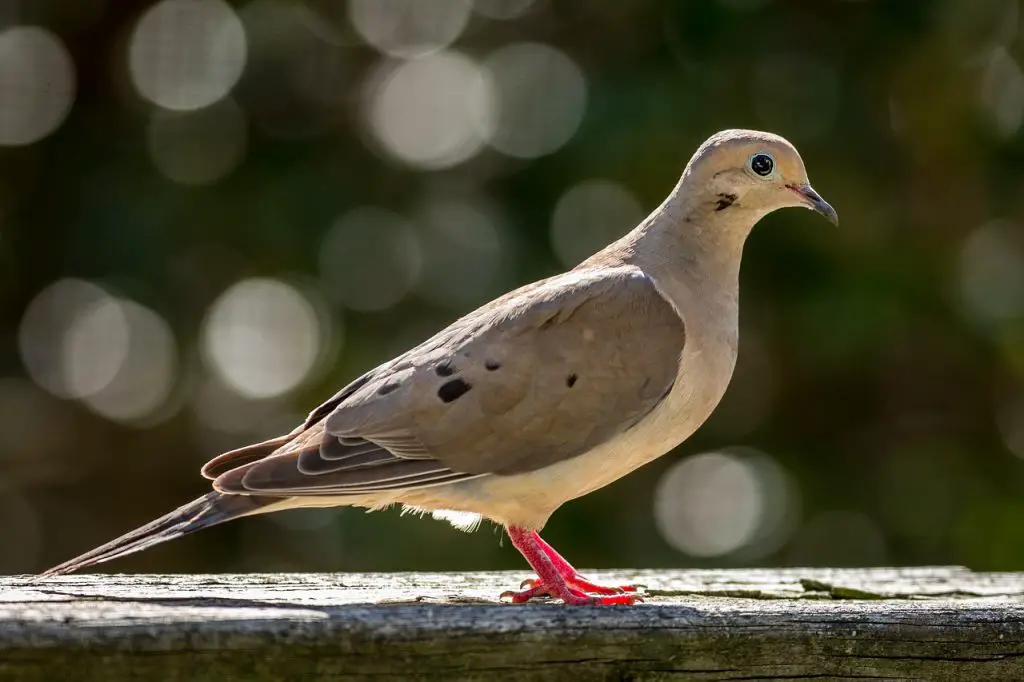
Scientific Name
The genus Zenaida encompasses six other species, each with its own unique characteristics and distribution. Among them, the mourning dove (Zenaida macroura) stands out with its five subspecies, with Z. m. macroura being the nominate subspecies. While their ranges may slightly overlap, each subspecies exhibits subtle variations in appearance.
The genus name, Zenaida, pays tribute to Zénaïde Laetitia Julie Bonaparte, wife of the renowned French ornithologist Charles Lucien Bonaparte and niece of Napoleon Bonaparte. Meanwhile, the species name, macroura, derives from the ancient Greek words “makros,” meaning “long,” and “-ouros,” meaning “-tailed,” reflecting the distinctive elongated tail of the mourning dove.
Close relatives of the mourning dove include the eared dove (Zenaida auriculata) and the Socorro dove (Zenaida graysoni), as well as members of the pigeon genus Patagioenas. However, it shares a more distant relationship with the wild or passenger pigeon (Ectopistes migratorius), tragically hunted to extinction in the early 1900s.
Interestingly, the mourning dove bears a striking resemblance to the European and North African species known as the “turtle dove” (Streptopelia turtur). However, the specific name “turtur” of the latter, which is a Latinization of its purring “turr turr turr” song, distinguishes it from the mourning dove.
Types
Scientists have classified the Mourning Dove into five distinct subspecies, each with its own geographical range:
- Zenaida macroura carolinensis: This subspecies inhabits regions including the Bahamas, Bermuda, eastern Canada, and the eastern United States.
- Zenaida macroura clarionensis: Found exclusively on Clarion Island, situated close to western Mexico.
- Zenaida macroura macroura: This subspecies resides in Cuba, the Dominican Republic, Haiti, Jamaica, and Puerto Rico.
- Zenaida macroura marginella: Its range includes western Canada, south-central Mexico, and the western United States.
- Zenaida macroura turturilla: Located in regions spanning from Costa Rica to western Panama.
Each subspecies exhibits unique characteristics and adaptations suited to its respective environment, contributing to the overall diversity and resilience of the Mourning Dove species.
Evolution and Classification
Mourning doves, belonging to the Zenaida genus, are part of a diverse avian family known as Columbidae, which encompasses a wide array of species native to the Americas. Alongside mourning doves, the Zenaida genus includes six other species:
- Eared doves
- Galápagos doves
- Socorro doves
- West Peruvian doves
- White-winged doves
- Zenaida doves
These birds are part of a broader family that boasts an impressive diversity, comprising 50 genera and 344 species in total. Within this family, members are commonly referred to as either doves or pigeons, with size often determining the distinction — doves typically being smaller, while pigeons tend to be larger.
One fascinating aspect shared by these birds is their ability to produce crop milk, a specialized substance used to feed their young, regardless of gender. Additionally, they exhibit a preference for a diet primarily composed of grains.
The evolutionary history of these birds stretches back to the Cretaceous Period, spanning an astonishing timeframe of 66 to 145 million years ago. During this epoch, they underwent rapid diversification, a process further accelerated by the Cretaceous–Paleogene extinction event, which occurred approximately 66 million years ago. This catastrophic event, responsible for the extinction of around 75% of Earth’s plant and animal species, played a significant role in shaping the evolutionary trajectory of these resilient birds.
Appearance
The Mourning Dove, characterized by its medium-sized, slender frame and graceful demeanor, boasts dimensions that range within a specific spectrum. Typically measuring between 22.5 to 36 centimeters (8.9 to 14.2 inches) in length, with an average length of 30.5 centimeters (12 inches), and weighing between 96 to 170 grams (3.4 to 6.0 ounces), averaging around 128 grams (4.5 ounces), it embodies elegance in its physical form. Its wingspan spans between 37 to 45 centimeters (14.6 to 17.7 inches), accentuating its aerial prowess.
Adorned in a plumage of light grey-brown with pinkish-grey tones below, the Mourning Dove’s aesthetic is complemented by black spotting adorning its wide, elliptical wings. Its elongated tail, tapering to a point, features white outer feathers juxtaposed against the inner feathers’ striking black hue. Its stature is further defined by short, reddish-colored legs, a rounded head, and a compact, dark brown-black beak.
Notable gender distinctions embellish the Mourning Dove’s appearance. Adult males showcase bright or iridescent purple-pink patches adorning the sides of their necks, transitioning into light pink hues along the breast, accompanied by a bluish-grey crown. In contrast, females exhibit a more subdued brown coloration overall, with slighter proportions compared to their male counterparts. These gender-based variations extend to the presence of vibrant feather patches, which are more pronounced in males.
During the juvenile stage, Mourning Doves present a scaly appearance, characterized by darker hues, gradually transitioning into the mature plumage as they reach three months of age. While the five subspecies exhibit similarities in appearance, subtle differences in coloring, beak structure, and leg length distinguish them from one another, contributing to the overall diversity within the Mourning Dove species.
Migration pattern and timing
Mourning Doves are a constant presence throughout the year in the United States, where they establish their habitats and thrive in various environments. During the warmer months, they extend their range northward, venturing into southern Canada to breed and raise their young amidst the verdant landscapes.
As the temperatures begin to drop and the days shorten, Mourning Doves embark on their annual migration southwards. Seeking warmer climates and ample food sources, they make their way to southern Central America, where they spend the winter months.
This migratory pattern allows Mourning Doves to adapt to changing environmental conditions and optimize their chances of survival throughout the year. Their ability to traverse vast distances showcases their resilience and resourcefulness in the face of seasonal challenges, ensuring their continued presence and prominence across the Americas.
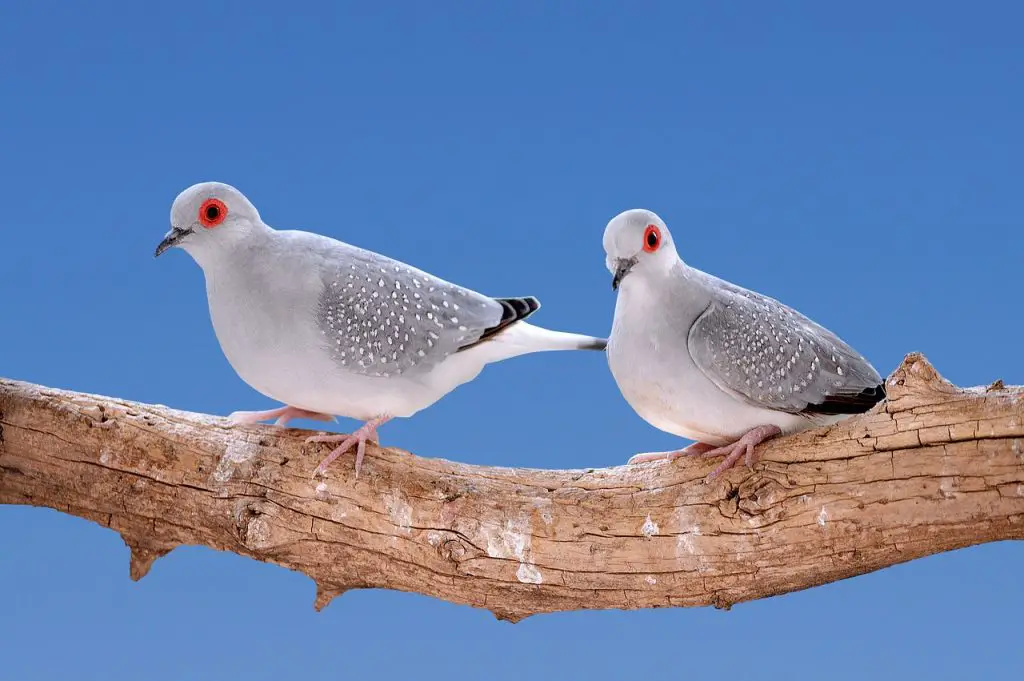
Behavior
The Mourning Dove’s vocalizations are characterized by a soft, drawn-out, mournful cooOOoo-woo-woo-woooo sound, often mistaken for the hooting of an owl. Interestingly, it’s the male Mourning Dove that produces this distinctive call as a wooing gesture, adding to its allure and mystique.
Pair bonding rituals among Mourning Doves involve tender acts of affection, such as mutual preening. This intimate gesture begins with gentle nibbling around the neck and progresses to grasping beaks and rhythmic head-bobbing in unison, strengthening the bond between mates.
When temperatures soar, Mourning Doves resort to panting to cool down since they lack sweat glands. They rely on drinking copious amounts of water, which they achieve through suction. Additionally, they indulge in sunbathing or rain showers, often assuming a distinctive posture of leaning over a flat surface, stretching one wing, earning them the endearing moniker “rain dove.” They also partake in water bathing in shallow pools or birdbaths and engage in dust bathing to maintain their plumage.
In flight, Mourning Doves exhibit remarkable speed and precision, darting through the air with bullet-straight trajectories. During the non-breeding season, they congregate in communal roosts within trees, adopting a unique sleeping posture by resting their heads between their shoulders, close to their bodies.
A fascinating defensive strategy employed by Mourning Dove parents involves distraction techniques to deter predators from their nests. In a selfless act, a parent will feign injury, fluttering and flapping on the ground at a distance, before swiftly flying away from the perceived threat, diverting attention from the vulnerable nest and offspring. This clever tactic demonstrates the Mourning Dove’s ingenuity and commitment to ensuring the safety of their progeny.
Diet
Mourning Doves are predominantly herbivorous, with their diet consisting primarily of a diverse array of grass and grain seeds, comprising about 99% of their nutritional intake. While seeds are their mainstay, they occasionally supplement their diet with small amounts of snails and insects.
To aid in digestion, Mourning Doves have developed a unique habit of ingesting grit, typically in the form of fine gravel or sand. This grit serves as an abrasive agent in their crop, assisting in the breakdown of seeds and enhancing nutrient absorption.
Ground foragers by nature, Mourning Doves prefer to feed on seeds and grains that are readily accessible on the ground or perched atop plants. Their feeding habits are characterized by a keen eye for spotting food sources within their immediate surroundings.
For a comprehensive understanding of the Mourning Dove’s dietary preferences and habits, you can explore our dedicated resource on “What Do Doves Eat?” to delve deeper into their culinary preferences and foraging behavior.
What do mourning doves eat?
Mourning Doves have a diverse palate, relishing a wide range of seeds and grains including rapeseed, corn, millet, safflower, sunflower, pine nuts, sweetgum seeds, pokeberry, amaranth, canary grass, sesame, and wheat seeds. Additionally, they savor buckwheat, rye, goosegrass, and smartweed seeds, all contributing to their varied and nutritious diet. Among their favorites is corn, a particularly beloved treat for these feathered foragers.
Predators and Threats
Mourning Doves face several threats in their natural environment, with cats ranking among the most significant. As natural predators, cats pose a constant danger to Mourning Doves and their offspring, often preying upon them with stealth and agility.
Furthermore, Mourning Doves are considered game birds in 40 states, subjecting them to hunting pressures. This hunting activity not only impacts adult doves but also poses a risk to their vulnerable offspring.
Diurnal birds of prey such as hawks and falcons, along with corvids, grackles, and rat snakes, are additional predators that pose a threat to Mourning Doves and their young. These opportunistic hunters target doves as a readily available food source, further increasing the challenges faced by this species.
Lead poisoning is another significant concern for Mourning Doves, particularly resulting from ingesting spent shot in hunting fields. This toxic exposure can have detrimental effects on their health and population viability.
In some cases, hunters may plant specific seed plants favored by Mourning Doves to attract them to hunting sites, inadvertently exacerbating the risk of lead poisoning and hunting-related mortality.
Addressing these threats through conservation efforts and responsible hunting practices is essential for ensuring the long-term survival and well-being of Mourning Doves in their natural habitat.
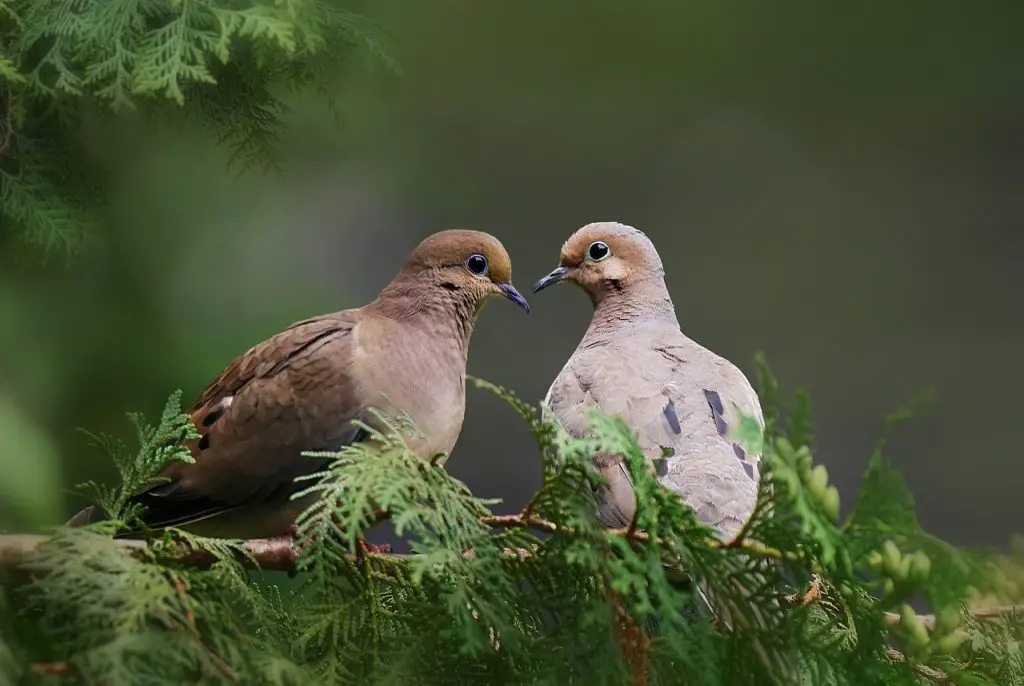
Reproduction, Babies, and Lifespan
Mourning Doves are proactive in their reproductive efforts, typically commencing nest building as early as March, with the peak breeding season spanning from April to July. However, in certain regions, breeding may extend as late as October, reflecting the species’ adaptability to varying environmental conditions.
Monogamous by nature, Mourning Doves form enduring pair bonds and often remain with the same mate for successive breeding seasons. This commitment is crucial as Mourning Doves are prolific breeders, capable of producing up to six broods in a single season. Such high reproductive output is necessary to offset the considerable mortality rates, which stand at 58% for adults and 69% for young birds annually.
Nest selection is a collaborative effort, with males presenting potential nesting sites to females for evaluation. Once a suitable site is chosen, typically within dense deciduous or coniferous trees, the female takes charge of nest construction, aided by the male. Together, they fashion the nest using twigs, conifer needles, and grass blades, sometimes repurposing existing nests from their own or other species.
Clutches typically consist of 1-2 eggs, which the female incubates for approximately two weeks before hatching. The hatchlings, known as squabs, are initially fed crop milk by both parents for the first 3-4 days before transitioning to a diet of seeds. Fledging occurs within 11-15 days, after which the young birds continue to be fed by their father for up to two weeks.
The first molt occurs at three months of age, marking the transition to adulthood. Subsequent molts occur every 14 days, ensuring the maintenance of healthy plumage. By 85 days of age, juveniles reach maturity and are capable of breeding.
Survival beyond the first year is critical for Mourning Doves, with individuals in the wild typically living for 4-5 years. In captivity, they can thrive for considerably longer, with lifespans extending up to 19 years. This longevity underscores the resilience and adaptability of the Mourning Dove species.
Population
The conservation status of the Mourning Dove, as assessed by the IUCN Red List, is Least Concern, indicating that the species is not currently facing significant threats to its overall population.
With an estimated population size of 475 million and showing signs of increase, the Mourning Dove’s resilience and adaptability have contributed to its robust numbers across its range.
However, in the 40 states where hunting is permitted, the Mourning Dove faces significant mortality rates due to hunting activities. Annually, between 20 million and up to 40–70 million individuals are shot by hunters, posing a notable pressure on local populations.
Furthermore, in the western United States, populations have experienced declines attributed to lead poisoning resulting from ingesting spent shot. This environmental hazard has impacted the health and survival of Mourning Doves in affected regions.
Addressing these threats requires ongoing conservation efforts, including the promotion of responsible hunting practices, the implementation of non-toxic alternatives to lead ammunition, and habitat conservation measures to safeguard Mourning Dove populations and ensure their continued stability in the wild.
Conclusion
The Mourning Dove stands as a resilient and adaptable species, thriving across diverse habitats throughout North and Central America. Despite facing challenges such as hunting pressures and lead poisoning, its population remains robust, with an estimated 475 million individuals and increasing. With its melodious calls, graceful flight, and tender mating rituals, the Mourning Dove holds a special place in both natural ecosystems and human culture, serving as a symbol of peace, resilience, and the enduring beauty of the avian world. Continued conservation efforts are essential to ensure the long-term survival and well-being of this beloved bird species.
